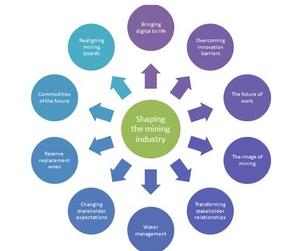Can Management Changes Break Gold’s Price Ceiling?
The gold mining industry is on a track to reverse its traditional method of mining to generate better shareholder returns.
Nov. 20 2020, Updated 3:11 p.m. ET

VanEck
Lasting Management Changes Key to Rekindling Investor Interest
Gold equity valuations are attractive, yet few investors are interested in gold stocks in the current environment. In order to attract investors in the next cycle, we feel companies must show that all of these changes are fundamental and lasting, rather than window dressing to cope with low gold prices. We believe there have been several fundamental changes that insure that wasteful management practices are gone for good:
- Management incentives have changed substantially at the board level. Historically, incentives were centered on production growth. However, it has become very difficult for large gold companies to generate growth and shareholder returns simultaneously. Returns suffered as the quality of gold deposits have declined and costs to develop have increased. Recently boards have restructured incentives to focus on returns rather than growth. As a result, managements are finding innovative ways to mine efficiently and build projects that contribute more to the bottom line.
- We expect shareholders to be more vigilant in holding managements accountable. The bear market from 2011 to 2015 was the worst peak to trough performance ever for gold equities. Investors have scars that will not be forgotten as the gold price improves. A recent example of shareholder involvement is Detour Gold (0% of net assets*), who operates the largest open pit gold mine in Ontario, Canada. A June Bloomberg article shows many of the company’s largest shareholders are unhappy with management. A letter to the company that was made public states that directors had “failed to recruit and oversee a management team capable of operating the Detour Lake mine in a manner that delivers returns to shareholders.”
- Passive gold equity funds have changed the structure of capital formation. In 2011, assets under management (AUM) by dedicated precious metals equity funds was divided 94% active (mainly mutual funds) versus 6% passive (ETFs). CIBC estimates the split is now 33% active and 67% passive. AUM of the 17 active gold equity funds in the U.S. listed on Bloomberg totals $10.5 billion, while the gold equity ETF’s VanEck Vectors® Gold Miners ETF (GDX) and VanEck Vectors® Junior Gold Miners ETF (GDXJ) alone have AUM of $12.3 billion. Passive funds are not able to participate in secondary offerings or initial public offerings (IPOs). This reduced pool of active funds means the industry has fewer options when it comes to raising capital. We believe companies have no choice but to become more fiscally disciplined to generate funding internally.
We will soon see if the gold price again shows positive moves following the July 4th holiday week. We continue to believe gold may take another run at the $1,365 per ounce level that has served as the price ceiling since 2014. A successful test of this level is probably needed to bring investor interest back to gold stocks.
Market Realist
Gold mining industry’s changing trends
The gold mining industry is on a track to change traditional mining methods to generate better shareholder returns, as we discussed in the previous part of this series. Many gold mining companies have adopted new techniques and a more conservative approach towards investments to develop their mines. The Deloitte mining trend report discusses ten trends and issues that are expected to shape the mining industry in 2018 as shown in the chart below. Kevin Xu, the mining leader for Deloitte China, mentioned in the paper that the mining industry also needs to explore better ways of replacing reserves that will permit miners to engage in exploration and development without sacrificing massive amounts of capital for long periods of time.
The Deloitte report also says that some other important strategies that could help miners include digital and innovative technologies to change the way they do business, better water management techniques, and catering to shareholder expectations better. According to the Globe and Mail, gold analyst John Ing, chief executive at Maison Placements Canada, mentioned that he believes that gold (GLD) (GDX) (GDXJ) has to break its price ceiling and cross $1,400 to regain investor interest.
The stock market and risk go hand-in-hand, and any slight trigger could set off the market. Geopolitical tensions and the declining dollar could all support gold, as it is a safe-haven asset. In its mid-year outlook, the World Gold Council mentioned that the following trends could drive gold in the second half of 2018:
- uneven global economic growth
- trade wars and their impact on currency
- rising inflation
- an inverted yield curve
- China’s expanding economy
- India’s festive season as a driver of gold demand
All investments carry some amount of risk, so investors need to consider these risks before making investment decisions.
